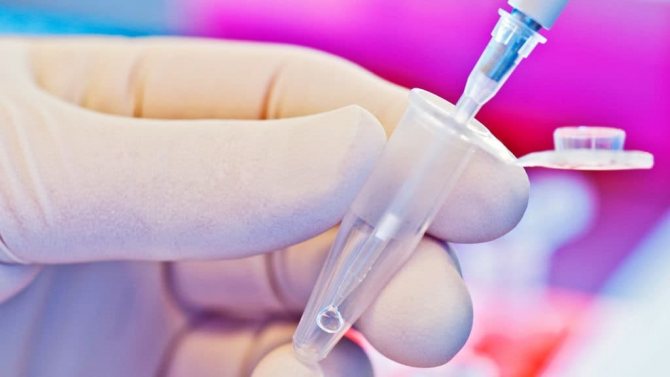The genetic DNA paternity test service, which is offered by laboratories in many countries around the world, has emerged as a commercial offshoot of forensic genomic fingerprinting. Thus, its goal is not to identify the criminal or victim, but to confirm paternity. In order for this type of examination to have legal force and be recognized by the judicial authorities of various countries, it was necessary to develop a unified approach to its implementation. Due to this, DNA paternity testing is widely used to resolve many personal doubts, as well as as a means of establishing the truth when considering family issues in court.
The Scientific Basis of a Paternity Test
The basis for the creation of a method for establishing paternity and similar genetic examinations was an understanding of the nature of human heredity. At conception, an embryo receives one half of its chromosomes from its mother and the other from its father. In this case, a random exchange of individual sections of male and female chromosomes occurs with each other, which determines the genetic uniqueness of each of the billions of living people.
So, although any child is unique, its genetic material contains a “mosaic” obtained by merging the chromosomes of the biological father and mother, respectively, a quarter from grandparents, ⅛ from great-grandparents, and so on. By comparing the corresponding parts of such a “mosaic” of the child’s DNA with the DNA of the putative parent, it is possible to establish or refute the fact of paternity, since in the case of kinship, almost all fragments will have identical values.
This comparison is made based on certain characteristics. The global scientific community has identified special regions of chromosomes called loci. They consist of repeating sequences of two or more nucleotide pairs and encode one or another hereditary information. Alphanumeric identification of such regions is accepted, for example, STR loci D7S820, CSF1PO, D19S433.
The most common system in the world is the American system for genetic analysis. It includes 14 STR loci. Considering that they are independently distributed on different chromosomes, this allows us to guarantee high accuracy of the results obtained.
It is worth noting that if a paternity test is performed on a pair of “alleged father” and “son”, then the analysis is performed on the Y chromosome, which is present only in males and is transmitted almost unchanged through the male line for many generations. Thus, the presence of discrepancies in its structure will make it possible to unequivocally refute paternity. In other cases (when it is necessary to establish paternity in relation to a daughter), analysis of autosomal loci (located on 22 pairs of non-sex chromosomes) is used.
Procedure for establishing paternity:
- first, a deoxyribonucleic acid molecule of the desired type is isolated from the obtained samples and split into fragments;
- using the polymerase chain reaction (PCR) method, the required section is copied (amplified) in order to increase the concentration of the desired fragments;
- the resulting material is analyzed to determine whether the alleles of the loci match the DNA of the second participant;
- a conclusion is made to establish or refute paternity with the issuance of an official laboratory report.
To eliminate human error, some laboratories perform this work with the help of two different groups of researchers, who then compare the results with each other.
Who needs genetic testing?
- Genetic analysis allows us to determine a person’s predisposition to various diseases.
- Used in family planning to identify the risk of giving birth to a child with a congenital pathology.
- Genetic analysis can be carried out as part of a fetal examination if the likelihood of a hereditary disease is high and in order to decide on termination of pregnancy it is necessary to determine the genetic code or karyotype of the unborn baby.
- In addition, genetic tests are carried out to determine a person’s personality, paternity, tendency to be overweight, develop a special diet and recommendations for lifestyle correction based on the genetic risk of developing a certain disease.
Genetic tests can be carried out on the recommendation of a geneticist or at the patient’s own request.
Procedure for establishing paternity
The use of the result of a DNA paternity test as a basis for making a decision in court is regulated by the Order of the Ministry of Health. For a family relationship to be proven, it is enough to receive a positive answer from a laboratory genetic study with an accuracy of at least 99.90%. Although depending on the number of loci used for analysis, the accuracy exceeds this value, even this is sufficient for the court to rule that “paternity is practically proven.”
The accuracy of a positive result is not 100%, since even with a complete match of the studied chromosome regions, it is impossible to completely exclude the presence of a genetic double in a person. For example, this situation occurs with identical twins. Their genetic profile matches. When the test result refutes paternity, it always has an accuracy of 100%, since the mismatch of one or two loci (depending on the number of markers analyzed) clearly indicates that the person being tested is not the biological father of the child.
It is worth noting that in the event of litigation on this issue, judges, as a rule, insist that the examination be carried out not only using biological material from the alleged father, but also samples from the child’s mother. This makes it easier to achieve the required level of accuracy, although not necessarily in terms of the technical capabilities of a modern genetic laboratory. At the same time, compliance with the court’s requirement is mandatory and allows you to obtain an expert opinion, the reliability of which there is no doubt.
The results of the study are not influenced by any external factors. Moreover, the structure of the genome remains unchanged throughout life.
Some of the cases when such an examination is necessary for the court:
- divorce proceedings and alimony collection;
- immigration issues, the resolution of which requires establishing the fact of family relationships;
- determination of heirs for distribution of inheritance.
The legal procedure for establishing paternity requires that the research be conducted with the identification of its participants if the expert opinion is to be used in court. Therefore, in such cases, you must have identification documents with you.
Genetic tests: what are they?
- DNA analysis. In the narrow sense of the word, DNA analysis is understood as a method of comparing DNA sections of two or more people to determine the degree of their relationship. In a broad sense, DNA diagnostics is a set of methods for studying the structure of DNA. Using DNA analysis, it is possible to determine the predisposition or presence of genetic diseases (hemophilia, phenylketonuria, cystic fibrosis), as well as multifactorial diseases.
- Cytogenetic analysis, or chromosomal analysis (karyotyping). This is the study of the number, shape and structure of chromosomes in germ and somatic cells. Most often used at the stage of prenatal diagnosis. Using cytogenetic analysis, chromosomal diseases are detected (Down syndrome, Patau syndrome, Edwards syndrome and others).
Any human tissue can serve as material for genetic analysis. The most commonly used are saliva, scrapings of the oral mucosa, blood, nails, hair, sperm, embryonic tissue cells, chorionic villi, amniotic fluid, abortive tissue, etc.
What do you need for a paternity test?
Once upon a time, exclusively venous blood was used for such analyzes. Therefore, it was impossible to do without a medical worker. Modern laboratory capabilities make it possible to use simpler biological materials, the collection of which can be carried out even at home. A generally accepted and standard method is the so-called buccal smear, when the buccal epithelium is collected from the oral cavity using a special cotton swab. This method is absolutely painless (which is especially important for children) and takes a minimum of time.
The most common samples also include hair follicles, nails, and earwax. Non-standard materials are used in cases where other methods of obtaining biological samples are not possible. This could be a toothbrush, pacifier, cigarette filter, cocktail sticks, cutlery, and the like.
Since samples for testing can be collected yourself, it is important to do this correctly and maintain sterility, for example, by performing a buccal swab. So, what is needed for a DNA paternity test:
- within an hour before collecting the material, refrain from eating, smoking, brushing your teeth and drinking anything except water;
- before starting the procedure, rinse your mouth with water;
- Using gloves, take the stick out of the newly opened package and run it 10-15 times along the inside of your cheek (please note that you don’t have to use special sticks to carry out a DNA test; you can buy the most common ear cleaning sticks at any pharmacy or supermarket, they will also fit);
- carefully cut off the tip of the stick that you were holding with scissors;
- Carefully place the stick with the sample in a paper (postal) envelope;
- repeat the procedure for the remaining 2-3 sticks;
- seal the envelope and sign it, for example, indicating: “Child” or “Father”;
- dry the envelope for 15 minutes in a dry and dark place without using heating devices or a hair dryer;
- perform the procedure for a second study participant;
- Deliver collected samples to the laboratory within 2-3 days.
Any non-standard materials should also be placed in a paper envelope, and samples should not be touched with bare hands; it is recommended to use medical gloves or tweezers.
When collecting material yourself, you cannot count on the legal validity of the results of the analysis performed. They can only be used for a private application - an information test.
Sample collection
This is perhaps the easiest step. You can use the help of specialists and submit the material to a genetic center, or you can collect samples yourself.
An oral swab is the best material. There are special kits for collecting oral swabs, so this will not be difficult.
Non-standard samples. They are usually used if everything needs to be done secretly and confidentially or access to the person being studied is severely limited or impossible.

How much does the service cost?
The cost of performing a paternity test includes:
- consultation;
- costs for isolating biological samples;
- the cost of the research itself.
The final amount also depends on the composition of the subjects, since in some cases biological material is used not only from the possible father and child, but also from samples from his mother. Urgent completion of work is more expensive.
Honest's prices for paternity testing:
- for saliva - 12,000 rubles.
- saliva + non-standard material - 14,000 rubles.
- non-standard material - 16,000 rubles.
- determination of paternity by the father's relatives (grandmother, grandfather, etc.) - from 16,000 rubles.
The results of a DNA paternity test are drawn up on the laboratory’s letterhead and issued to the customer or sent to the court. In accordance with Federal Law No. 73, which regulates forensic activities in the Russian Federation, examinations can be carried out by non-governmental institutions if they have the appropriate license, laboratory equipment and specialists in the field of genetics and molecular biology.
For questions related to genetic testing, you can consult with Honesta specialists. It's free.
How reliable are the results of genetic analysis?
The reliability of genetic testing depends on the purpose and type of analysis. When establishing a person’s identity and degree of relationship, a reliability of 99.9% is achieved. Such results, if all conditions of the analysis are met, can even serve as evidence in court proceedings.
Genetic tests with a high degree of probability can confirm or refute the medical diagnosis of an existing disease if the corresponding symptoms are present.
When it comes to genetic analysis for family planning or genetic tests during pregnancy, their results can only suggest the risk of a particular pathology. Only the results of genetic analysis in this case are not a reliable criterion for deciding the issue of pregnancy. The positive result of such a study should be assessed only in conjunction with other data: data from an ultrasound examination of the fetus, biochemical blood tests for pregnancy markers (hCG, AFP) and others.
Expert: Natalya Dolgopolova, general practitioner Author: Tamara Lipina
The material uses photographs belonging to shutterstock.com








